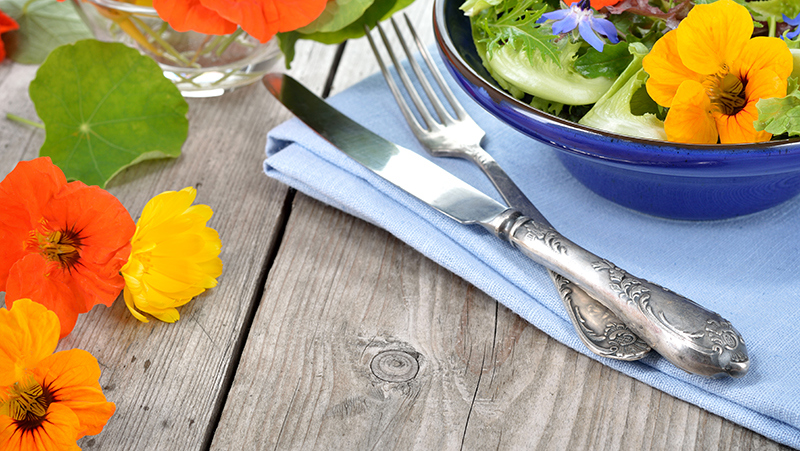Yates Account
Join now
Create a Yates account today!
Sign up to join the Yates Garden Club for monthly e-mails packed with seasonal inspiration, tips for success & exclusive promotions.
Plus if you’re a Garden Club member you can take part in the Yates Growing Community - a blog to share successes, get advice & win prizes in fun challenges along the way!

Forgot password
Enter the email address associated with your account, and we'll email you a new password.

If you are looking for an annual plant that provides your garden with colour and some protection from insects, you can’t go past Nasturtiums (Tropaeolum majus). Their bright and happy flowers and delicious scent not only brighten up your garden, but can also be used in your kitchen as both the leaves and flowers are edible. This is a real champion plant and a must have for any vegetable garden!
How to grow Nasturtium in a garden
Starting from a seedling or potted plant:
- Choose a position in full sun with well-drained soil.
- Enrich the soil with Yates Thrive Natural Blood & Bone with Seaweed.
- When planting into prepared garden bed, ensure seedlings are well spaced – at least 20 to 30cm apart.
- Dig the planting hole twice as wide and to the same depth as the root-ball. Remove the plant from the container. Position in hole and backfill, gently firming down. Form a raised doughnut shaped ring around the plant, creating a well so that water will go where it’s needed most.
- Water in gently and keep soil moderately moist at all times.
- Mulch with an organic mulch such as bark chips, woodchip or pea straw to a depth of 5 - 8cm, keeping it away from the base of the plant.
- Feed with Yates Thrive Rose & Flower Granular Plant Food. TIP: for an added boost, apply Yates Thrive Roses & Flowers Liquid Plant Food.
Starting from seed:
- Fill starter pots or trays with Yates Black Magic Seed Raising Mix. Sow seeds, lightly cover with a 12mm layer of mix, firm down and gently water in well. Keep moist at all times and place in a warm and sheltered position until seedlings have grown to 5 cm tall, then plant into the garden.
- Alternatively, sow direct where they are to grow in rows or in scattered clumps around the garden. Cover with a 12mm layer of Yates Black Magic Seed Raising Mix. Lightly firm down and keep moist. Just be sure to enrich the soil with Yates Thrive Natural Blood & Bone with Seaweed prior to sowing.

How to grow Nasturtium in a pot
Starting from a seedling or potted plant:
- Choose a pot at least 300mm wide with adequate drainage holes.
- Position pot in full sun.
- Fill the pot with a quality potting mix such as Yates Premium Potting Mix.
- Remove the plant from the container. Position in hole and backfill, gently firming down.
- Water in gently and keep mix moderately moist at all times.
- Feed with Yates Thrive Roses & Flowers Liquid Plant Food. TIP: for an added boost, apply Yates Thrive Natural Fish & Seaweed+ Plant Food Concentrate.
Starting from seed:
- Fill starter pots or trays with Yates Black Magic Seed Raising Mix. Sow seeds, lightly cover with a 12mm layer of mix, firm down and gently water in well. Keep moist at all times and place in a warm and sheltered position until seedlings have grown to 5 cm tall, then plant into the pot.
- Alternatively, sow directly into the pot where they are to grow. Cover with a 12mm layer of Yates Black Magic Seed Raising Mix. Lightly firm down and keep moist.
Growing tips
- Nasturtiums are the ultimate ‘decoy’ plant which makes them great for your vegetable patch. They are more attractive to insects such as aphids, mites, caterpillars and whiteflies which means that they will be attacked first leaving you a chance to control these pests before they reach your vegetables.
- Remove spent blooms to promote flowering.
- Leaves and flowers can be consumed and are a lovely addition to salads.
- Very attractive to bees.
An easy-to-grow, free-flowering variety producing a profusion of cherry-coloured blooms on dwarf plants.
Nasturtium 'Jewel Mixed'
Sweetly scented bursts of crimson, orange, yellow, salmon and rose rise above the slightly trailing foliage. Ideal for pots or ground cover.
More Plants
Orange Trumpet Vine
Orange trumpet vine, with its brilliant cascading masses of orange tubular flowers, is one of the most spectacular winter flowering climbers.
Spring Stars
Spring Stars are a versatile addition to any garden with delightful lavender-blue, star shaped blooms.
Flax
Flaxes (Phormium spp.) are highly versatile plants which don't mind swampy or dry conditions. Great for large pots or planted en-masse in garden beds.
Proteas
Not just any old blossom, protea flowers are blooms with attitude. If you can give them full sun and reasonable drainage, proteas will love you.
Recommended products
Yates Thrive Rose & Flower Granular Plant Food
Specially formulated to grow all types of flowers. With high potassium for large & abundant flowers, added calcium & iron for stronger flowers.
Yates Thrive Roses & Flowers Liquid Plant Food
Provides your flowers & roses with the balanced nutrients they require for healthy growth and flower production.
Yates Black Magic Seed Raising Mix
Specially formulated for trouble-free seed raising in trays (or outdoor seed sowing direclty into the ground) and propagation of cuttings.
Yates Thrive Natural Blood & Bone with Seaweed
A certified organic garden input boosted with NZ Seaweed to gently nourish plants, enrich the soil and encourage a strong healthy root system.


















Share
Share this article on social media